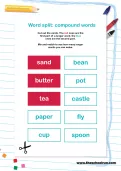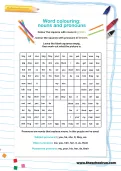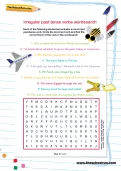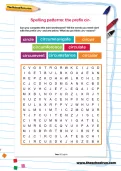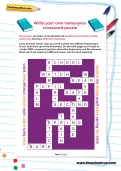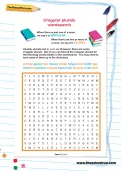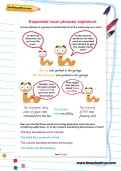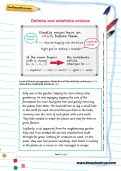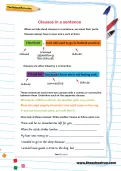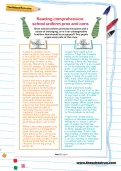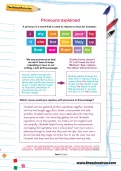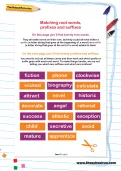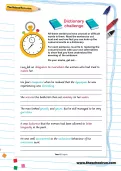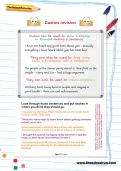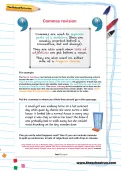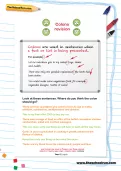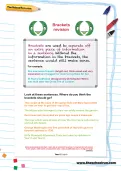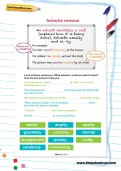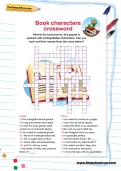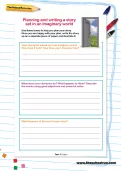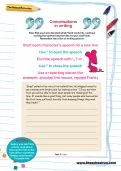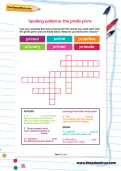See if you can find all the irregular plural nouns for the following words hidden in this teacher-created wordsearch. You may need to look some of them up in the dictionary.
or
Register to add to your saved resources
A noun phrase is a group of words that act in the same way as a noun. Can you rewrite these sentences using expanded noun phrases containing adjectives, or to tell readers something about place or time? Then rewrite these sentences using expanded noun phrases that use superlatives, or that mention a person.
or
Register to add to your saved resources
Already a subscriber? to view this content.
Usually nouns have an article before them. Look at these paragraphs. Underline all the definite articles in blue and all the indefinite articles in red.
or
Register to add to your saved resources
Already a subscriber? to view this content.
When we talk about clauses in a sentence, we mean their parts. Clauses always have a noun and a verb in them and are often linked by a connective. These sentences each have two clauses with a comma or connective between them. Underline each of the separate clauses.
or
Register to add to your saved resources
Semi-colons are used in a similar way to commas, but they mark a stronger division. Look at these sentences. Where do you think the semi-colon should go?
or
Register to add to your saved resources
Already a subscriber? to view this content.
Does school uniform promote discipline and a sense of belonging, or is it an unimaginative tradition that should be scrapped? Two pupils argue each side of the case. Read their arguments then answer the questions.
or
Register to add to your saved resources
Already a subscriber? to view this content.
This free Year 6 English worksheet was created by a primary-school teacher and explains in easy-to-understand language what pronouns are, providing helpful examples and a fun activity at the end!
or
Register to add to your saved resources
A Year 6 English worksheet created by a primary school teacher to help your child understand prefixes and suffixes, and practise matching root words.
or
Register to add to your saved resources
Already a subscriber? to view this content.
All these sentences have unusual or difficult words in them. Read the sentences out loud and see how fast you can look up the coloured words in a dictionary. For each sentence, re-write it, replacing the coloured words with your own alternatives to show that you have understood the meaning of the sentence. On your marks, get set...
or
Register to add to your saved resources
Already a subscriber? to view this content.
Dashes can be used to show a change in thought during a sentence. They can also be used to drop some extra information into a sentence or they can also be used to create emphasis. Look through these sentences and put dashes in where you think they should go.
or
Register to add to your saved resources
Already a subscriber? to view this content.
A useful commas worksheet for KS2 children, created by an experienced educator.
Commas are used to separate parts of a sentence (they are usually inserted before a connective, but not always). They are also used when lists of adjectives are put before a noun. They are also used on either side of a drop-in clause. Put the commas in where you think they should go in this passage.
or
Register to add to your saved resources
Already a subscriber? to view this content.
Colons are used in sentences when a fact or a list is being presented. Look at these sentences. Where do you think the colon should go?
or
Register to add to your saved resources
Already a subscriber? to view this content.
Brackets are used to separate off an extra piece of information in a sentence. Without the information in the brackets, the sentence would still make sense. Look at these sentences. Where do you think the brackets should go?
or
Register to add to your saved resources
Already a subscriber? to view this content.
An adverb modifies a verb (explains how it is being done). Adverbs usually end in -ly. Look at these sentences. What adverbs could you add to them?
or
Register to add to your saved resources
Already a subscriber? to view this content.
Classic characters are unforgettable, whether they're falling down unusual rabbit holes, prowling through the jungle or breaking their slates over unfortunate classmates' heads. How many famous characters from children's literature can you identify in this crossword puzzle?
or
Register to add to your saved resources
Green or barren, deserted or populated by amazing creatures – it's time to enter an imaginary world! Your child will need to write a story set in an environment of their choosing, using the planning frame to help them organise their ideas before they put pen to paper.
or
Register to add to your saved resources
Continue a conversation between two characters, remembering the rules of writing speech: Start each character’s speech on a new line, use “ to open the speech, end the speech with !, ? or , and use ” to close the speech. Don't forget to use a reporting clause (for example: shouted the mouse, replied Frank), too!
or
Register to add to your saved resources
Already a subscriber? to view this content.
Can you complete this mini-crossword? The words you need start with the prefix prim- and are listed below. What do you think prim- means?
or
Register to add to your saved resources
Already a subscriber? to view this content.
Paragraphs are sections of writing. In information texts, writers try to make sure that each area of the subject they are writing about is separated into paragraphs. Can you group the information on these pages into paragraphs?
or
Register to add to your saved resources
Already a subscriber? to view this content.
Read through this poem. In this poem, night is personified. Can you underline any phrases that suggest that night is a person? Then write down some of your ideas and use them to write your own poem that personifies night.
or
Register to add to your saved resources
Already a subscriber? to view this content.
